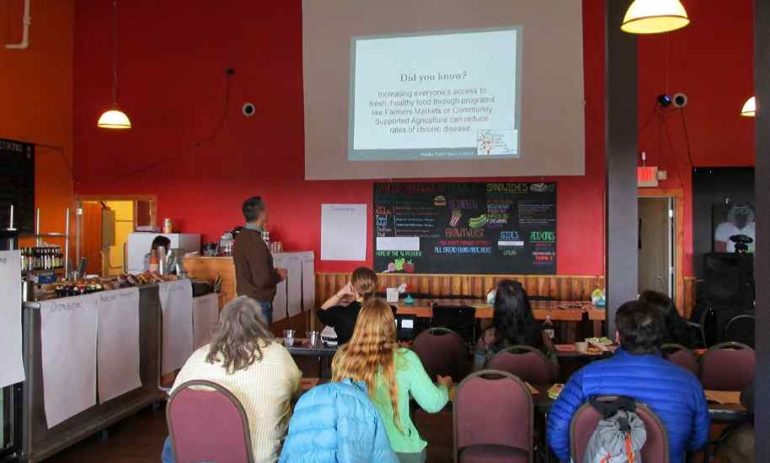The Alaska Food Policy Council (AFPC) spearheads the navigation of Alaska’s food system, which is complicated by its distance from the continental United States. It encourages collaboration amongst Alaskan farmers, fisheries, state institutions and agencies, tribal entities, and consumers.
Food Tank had the opportunity to speak with Samantha Ford, Coordinator at AFPC.
Food Tank (FT): How do you contribute to creating a better food system?
Samantha Ford (SF): The AFPC brings together farmers, fishermen, tribal leaders, food banks, government representatives, academics, and ordinary Alaskans who believe that all Alaskans have a right to affordable, healthy (preferably local) food. The AFPC seeks to offer support and serve as a resource for people engaged in food systems across Alaska. Some of our 2014 accomplishments include publishing Building Food Security in Alaska, an assessment of the Alaskan food system written with Ken Meter of the Crossroads Resource Center; conducting a series of town hall meetings in communities across the state to learn how they think we can improve; and developing a food security assessment that communities across Alaska are using to ensure they have sufficient food resources for emergency situations. We hosted our first conference, the Alaska Food Festival and Conference, in Anchorage, AK in November 2014 and we are already planning the next one, set for spring 2016!
FT: What is a project, program, or result you are most proud of?
SF: The work we are most proud of is our ongoing effort to get healthy, local, and traditional foods on the agenda of the state government and into institutions across the state. In 2013, our former Governor Sean Parnell created the Alaska Food Resource Working Group, composed of eight state agency Commissioners or designers responsible for the development, oversight, and marketing of locally grown and harvested food. The legislation specifies that the Working Group collaborates with the AFPC and a member of our Governing Board, Danny Consenstein. We have also advocated for funding programs that bring local foods to Alaskan schools through our alliance with the Farm to School program and the Native Alaskan Foods in Schools. Although these programs have historically been successful and popular, there have been setbacks in our efforts due to changes in our administration and budget. We remain proud of and committed to these efforts.
Finally, we have helped develop guidance materials to encourage increased use of traditional foods in institutions, with a particular focus on hospitals and nursing homes that serve Native Alaskans. We believe that culturally appropriate foods link Alaskans to their pasts and improve the health and well-being of some of our most vulnerable citizens. Bringing traditional foods into our state institutions promotes our goals of creating a healthy, self-reliant, and prosperous Alaska.
FT: What are your goals for this year and beyond?
SF: The AFPC’s goal is to become an even more recognized resource concerning activities that strengthen the Alaskan food system. This year we are focused on outreach and building our sustainability.
Our outreach efforts include publicizing our food system assessment, Building Food Security in Alaska, through a series of factsheets with specific recommendations. We are also collaborating with groups in Anchorage to ease the process of starting a farm or food business within the city limits. We want to work with the municipal government to make changes in the local food and zoning codes that would facilitate this important work. In the future, we hope to use this collaborative model throughout the state to empower individual communities to form local food councils.
We are also devoting significant energy to building the AFPC’s sustainability and independent voice. The AFPC started as a state-supported project of the Alaska State Department of Health and Social Services, but became an independent 501(c)(3) organization in the summer of 2014. We are excited about this new chapter, but it also means we need to develop independent sources of revenue.
FT: In one sentence, what is the most important thing eaters and consumers can do today to support a more sustainable food system?
SF: We can educate ourselves about the ways the current food system impacts health, environment, economy, and security; then use what we learn to vote—and spend—to make changes.
FT: How can individuals become more involved in your organization?
SF: Membership in the AFPC is open to everyone. Email us and ask to join our mailing list. Get more involved by checking out our Facebook page or, if you are in Alaska, consider joining a subcommittee to work on an issue you really care about.
Download the 2015 Good Food Org Guide HERE.







